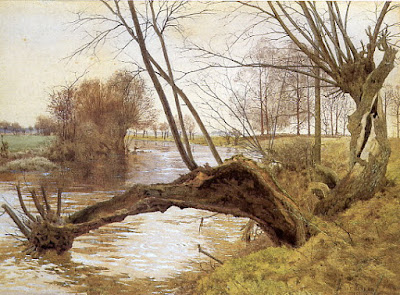Farmers would pollard willows to produce flexible rods; they'd cut back beeches to make charcoal; and they'd pollard hazels to produce nuts.
It was practiced in Europe and Asia, and among the indigenous populations of the new world.
Pollarding was commonly practiced for tens of thousands of years until it fell mostly out of favor in the industrial revolution.
Vincent van Gogh
By allowing a tree trunk to grow up to the height of a standing person before it bears tender shoots, the shoots and leaves are above the browse line of deer, sheep and other animals.
Vincent van Gogh
The small branches can be cut back again to the same point after two, four, eight, or ten years, to be used for animal feed, firewood, tool handles, or building materials.
Sir George Clausen, The Return from the Fields
Many of us have assumed that this practice disfigures trees, but it's quite the opposite, providing reliable raw materials for people, and a healthy renewing cycle for the trees. A pollarded tree can potentially live for a thousand years.
 |
According to author and arborist William Bryant Logan, it's not only healthy for the trees, but it expands the environment for a variety of other plants and animals.
Pollarded Willows, 1887 by William Fraser Garden
Pollarding is still practiced in Europe, but it's less common in the USA.
The place you tend to find it these days is in cities, where trees receive more attentive care than they do in the untended forests.
Ivan Shishkin, Coppice (Noon) 1872

----
Previous post on William Fraser Garden
















6 comments:
A great post. Thank you.
I've long noticed this in European paintings, particularly those from the 19th century. Interesting article, thanks.
Neat post. I lived in Geneva, Switzerland for a year and enjoyed seeing "pollarded" (new vocab word, thanks!) plane trees all over the place there, then missed them when I got back to the Midwestern US.
It's a neat look, very expressive -- the branches spray out like fireworks, atop a stately trunk.
We have a pair of pollarded Manitoba Maples in front of our white frame house in Bishops Mills, Ontario. We ‘inherited’ them from the previous owners. We have no idea how old they are, as they are quite hollow. One is growing out of a big burl at the base, and the trunk is partly twisted. This fall while trimming it, we carved away one side that was rotten - and with upstretched arms and a slice from one of the “heads” propped up to look like a face with two eyes, it looks like one of the ghoulish trees in an Arthur Rackham ink illustration. I put a toque and scarf on it for the winter. Wish I could show you what it looked like.
Speaking as someone exposed to the sights of pollarded trees all my life, - no matter what you say about it, it's ugly. It's not just that it _may_ look ugly, it is that it's ugly for many people, and that fact does not change with exposure.
And, arborists know that most trees respond to it badly.
The economic reasons for the practice are now gone, and the primary remaining reason : to control the tree height in inhabited areas, can be eliminated elegantly & economically by planting trees that naturally grow small in size.
And, we also know that plants react to being cut by releasing biochemical signals of alarm, which for all we know may be subjectively equivalent to our experience of pain, so that there are also holistic reasons to be reserved about pollarding.
Speaking as someone whos exposed to the sight all my life, ...no matter how look at it they are cultural part of the Dutch landscape. The fact that the aren't much of a use now a day, which they should btw.they stil play a huge role in the bio-diversity and even the wildlife structure in a landscape, ... nesting holes infrastructural and so on. I agree however with JR (Jos van Riswick?)they are ugly to paint, ... like argical plastics of hay bales wraped in them. Besides Pollards are used to make aspirine aswell in those days, ...and wooden shoes and all kind of stuff.
Farmers convenients wood they called them here.
"Boeren geriefhout"
A nice detail aside, did you know that the "brakes" on old Dutch windmils are made of willow, ... the amount of water in them prevents the brakes to catch fire!
Post a Comment